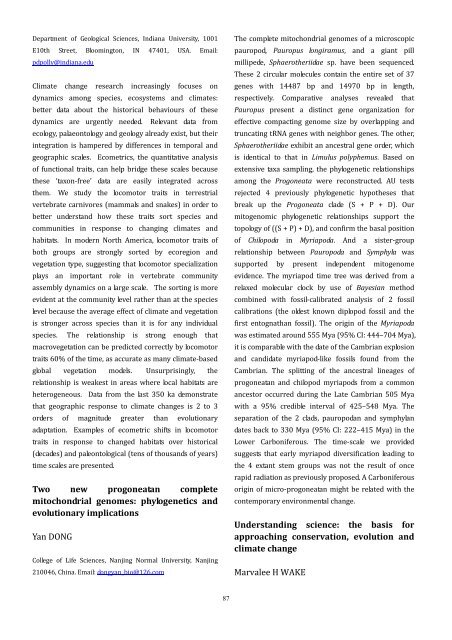Welcome to the 31st IUBS General Assembly and Conference on ...
Welcome to the 31st IUBS General Assembly and Conference on ...
Welcome to the 31st IUBS General Assembly and Conference on ...
You also want an ePaper? Increase the reach of your titles
YUMPU automatically turns print PDFs into web optimized ePapers that Google loves.
Department of Geological Sciences, Indiana University, 1001<br />
E10th Street, Blooming<str<strong>on</strong>g>to</str<strong>on</strong>g>n, IN 47401, USA. Email:<br />
pdpolly@indiana.edu<br />
Climate change research increasingly focuses <strong>on</strong><br />
dynamics am<strong>on</strong>g species, ecosystems <str<strong>on</strong>g>and</str<strong>on</strong>g> climates:<br />
better data about <str<strong>on</strong>g>the</str<strong>on</strong>g> his<str<strong>on</strong>g>to</str<strong>on</strong>g>rical behaviours of <str<strong>on</strong>g>the</str<strong>on</strong>g>se<br />
dynamics are urgently needed. Relevant data from<br />
ecology, palae<strong>on</strong><str<strong>on</strong>g>to</str<strong>on</strong>g>logy <str<strong>on</strong>g>and</str<strong>on</strong>g> geology already exist, but <str<strong>on</strong>g>the</str<strong>on</strong>g>ir<br />
integrati<strong>on</strong> is hampered by differences in temporal <str<strong>on</strong>g>and</str<strong>on</strong>g><br />
geographic scales. Ecometrics, <str<strong>on</strong>g>the</str<strong>on</strong>g> quantitative analysis<br />
of functi<strong>on</strong>al traits, can help bridge <str<strong>on</strong>g>the</str<strong>on</strong>g>se scales because<br />
<str<strong>on</strong>g>the</str<strong>on</strong>g>se ‘tax<strong>on</strong>‐free’ data are easily integrated across<br />
<str<strong>on</strong>g>the</str<strong>on</strong>g>m. We study <str<strong>on</strong>g>the</str<strong>on</strong>g> locomo<str<strong>on</strong>g>to</str<strong>on</strong>g>r traits in terrestrial<br />
vertebrate carnivores (mammals <str<strong>on</strong>g>and</str<strong>on</strong>g> snakes) in order <str<strong>on</strong>g>to</str<strong>on</strong>g><br />
better underst<str<strong>on</strong>g>and</str<strong>on</strong>g> how <str<strong>on</strong>g>the</str<strong>on</strong>g>se traits sort species <str<strong>on</strong>g>and</str<strong>on</strong>g><br />
communities in resp<strong>on</strong>se <str<strong>on</strong>g>to</str<strong>on</strong>g> changing climates <str<strong>on</strong>g>and</str<strong>on</strong>g><br />
habitats. In modern North America, locomo<str<strong>on</strong>g>to</str<strong>on</strong>g>r traits of<br />
both groups are str<strong>on</strong>gly sorted by ecoregi<strong>on</strong> <str<strong>on</strong>g>and</str<strong>on</strong>g><br />
vegetati<strong>on</strong> type, suggesting that locomo<str<strong>on</strong>g>to</str<strong>on</strong>g>r specializati<strong>on</strong><br />
plays an important role in vertebrate community<br />
assembly dynamics <strong>on</strong> a large scale. The sorting is more<br />
evident at <str<strong>on</strong>g>the</str<strong>on</strong>g> community level ra<str<strong>on</strong>g>the</str<strong>on</strong>g>r than at <str<strong>on</strong>g>the</str<strong>on</strong>g> species<br />
level because <str<strong>on</strong>g>the</str<strong>on</strong>g> average effect of climate <str<strong>on</strong>g>and</str<strong>on</strong>g> vegetati<strong>on</strong><br />
is str<strong>on</strong>ger across species than it is for any individual<br />
species. The relati<strong>on</strong>ship is str<strong>on</strong>g enough that<br />
macrovegetati<strong>on</strong> can be predicted correctly by locomo<str<strong>on</strong>g>to</str<strong>on</strong>g>r<br />
traits 60% of <str<strong>on</strong>g>the</str<strong>on</strong>g> time, as accurate as many climate‐based<br />
global vegetati<strong>on</strong> models. Unsurprisingly, <str<strong>on</strong>g>the</str<strong>on</strong>g><br />
relati<strong>on</strong>ship is weakest in areas where local habitats are<br />
heterogeneous. Data from <str<strong>on</strong>g>the</str<strong>on</strong>g> last 350 ka dem<strong>on</strong>strate<br />
that geographic resp<strong>on</strong>se <str<strong>on</strong>g>to</str<strong>on</strong>g> climate changes is 2 <str<strong>on</strong>g>to</str<strong>on</strong>g> 3<br />
orders of magnitude greater than evoluti<strong>on</strong>ary<br />
adaptati<strong>on</strong>. Examples of ecometric shifts in locomo<str<strong>on</strong>g>to</str<strong>on</strong>g>r<br />
traits in resp<strong>on</strong>se <str<strong>on</strong>g>to</str<strong>on</strong>g> changed habitats over his<str<strong>on</strong>g>to</str<strong>on</strong>g>rical<br />
(decades) <str<strong>on</strong>g>and</str<strong>on</strong>g> pale<strong>on</strong><str<strong>on</strong>g>to</str<strong>on</strong>g>logical (tens of thous<str<strong>on</strong>g>and</str<strong>on</strong>g>s of years)<br />
time scales are presented.<br />
Two new prog<strong>on</strong>eatan complete<br />
mi<str<strong>on</strong>g>to</str<strong>on</strong>g>ch<strong>on</strong>drial genomes: phylogenetics <str<strong>on</strong>g>and</str<strong>on</strong>g><br />
evoluti<strong>on</strong>ary implicati<strong>on</strong>s<br />
Yan DONG<br />
College of Life Sciences, Nanjing Normal University, Nanjing<br />
210046, China. Email: d<strong>on</strong>gyan_bio@126.com<br />
The complete mi<str<strong>on</strong>g>to</str<strong>on</strong>g>ch<strong>on</strong>drial genomes of a microscopic<br />
pauropod, Pauropus l<strong>on</strong>giramus, <str<strong>on</strong>g>and</str<strong>on</strong>g> a giant pill<br />
millipede, Sphaero<str<strong>on</strong>g>the</str<strong>on</strong>g>riidae sp. have been sequenced.<br />
These 2 circular molecules c<strong>on</strong>tain <str<strong>on</strong>g>the</str<strong>on</strong>g> entire set of 37<br />
genes with 14487 bp <str<strong>on</strong>g>and</str<strong>on</strong>g> 14970 bp in length,<br />
respectively. Comparative analyses revealed that<br />
Pauropus present a distinct gene organizati<strong>on</strong> for<br />
effective compacting genome size by overlapping <str<strong>on</strong>g>and</str<strong>on</strong>g><br />
truncating tRNA genes with neighbor genes. The o<str<strong>on</strong>g>the</str<strong>on</strong>g>r,<br />
Sphaero<str<strong>on</strong>g>the</str<strong>on</strong>g>riidae exhibit an ancestral gene order, which<br />
is identical <str<strong>on</strong>g>to</str<strong>on</strong>g> that in Limulus polyphemus. Based <strong>on</strong><br />
extensive taxa sampling, <str<strong>on</strong>g>the</str<strong>on</strong>g> phylogenetic relati<strong>on</strong>ships<br />
am<strong>on</strong>g <str<strong>on</strong>g>the</str<strong>on</strong>g> Prog<strong>on</strong>eata were rec<strong>on</strong>structed. AU tests<br />
rejected 4 previously phylogenetic hypo<str<strong>on</strong>g>the</str<strong>on</strong>g>ses that<br />
break up <str<strong>on</strong>g>the</str<strong>on</strong>g> Prog<strong>on</strong>eata clade (S + P + D). Our<br />
mi<str<strong>on</strong>g>to</str<strong>on</strong>g>genomic phylogenetic relati<strong>on</strong>ships support <str<strong>on</strong>g>the</str<strong>on</strong>g><br />
<str<strong>on</strong>g>to</str<strong>on</strong>g>pology of ((S + P) + D), <str<strong>on</strong>g>and</str<strong>on</strong>g> c<strong>on</strong>firm <str<strong>on</strong>g>the</str<strong>on</strong>g> basal positi<strong>on</strong><br />
of Chilopoda in Myriapoda. And a sister‐group<br />
relati<strong>on</strong>ship between Pauropoda <str<strong>on</strong>g>and</str<strong>on</strong>g> Symphyla was<br />
supported by present independent mi<str<strong>on</strong>g>to</str<strong>on</strong>g>genome<br />
evidence. The myriapod time tree was derived from a<br />
relaxed molecular clock by use of Bayesian method<br />
combined with fossil‐calibrated analysis of 2 fossil<br />
calibrati<strong>on</strong>s (<str<strong>on</strong>g>the</str<strong>on</strong>g> oldest known diplopod fossil <str<strong>on</strong>g>and</str<strong>on</strong>g> <str<strong>on</strong>g>the</str<strong>on</strong>g><br />
first en<str<strong>on</strong>g>to</str<strong>on</strong>g>gnathan fossil). The origin of <str<strong>on</strong>g>the</str<strong>on</strong>g> Myriapoda<br />
was estimated around 555 Mya (95% CI: 444–704 Mya),<br />
it is comparable with <str<strong>on</strong>g>the</str<strong>on</strong>g> date of <str<strong>on</strong>g>the</str<strong>on</strong>g> Cambrian explosi<strong>on</strong><br />
<str<strong>on</strong>g>and</str<strong>on</strong>g> c<str<strong>on</strong>g>and</str<strong>on</strong>g>idate myriapod‐like fossils found from <str<strong>on</strong>g>the</str<strong>on</strong>g><br />
Cambrian. The splitting of <str<strong>on</strong>g>the</str<strong>on</strong>g> ancestral lineages of<br />
prog<strong>on</strong>eatan <str<strong>on</strong>g>and</str<strong>on</strong>g> chilopod myriapods from a comm<strong>on</strong><br />
ances<str<strong>on</strong>g>to</str<strong>on</strong>g>r occurred during <str<strong>on</strong>g>the</str<strong>on</strong>g> Late Cambrian 505 Mya<br />
with a 95% credible interval of 425–548 Mya. The<br />
separati<strong>on</strong> of <str<strong>on</strong>g>the</str<strong>on</strong>g> 2 clads, pauropodan <str<strong>on</strong>g>and</str<strong>on</strong>g> symphylan<br />
dates back <str<strong>on</strong>g>to</str<strong>on</strong>g> 330 Mya (95% CI: 222–415 Mya) in <str<strong>on</strong>g>the</str<strong>on</strong>g><br />
Lower Carb<strong>on</strong>iferous. The time‐scale we provided<br />
suggests that early myriapod diversificati<strong>on</strong> leading <str<strong>on</strong>g>to</str<strong>on</strong>g><br />
<str<strong>on</strong>g>the</str<strong>on</strong>g> 4 extant stem groups was not <str<strong>on</strong>g>the</str<strong>on</strong>g> result of <strong>on</strong>ce<br />
rapid radiati<strong>on</strong> as previously proposed. A Carb<strong>on</strong>iferous<br />
origin of micro‐prog<strong>on</strong>eatan might be related with <str<strong>on</strong>g>the</str<strong>on</strong>g><br />
c<strong>on</strong>temporary envir<strong>on</strong>mental change.<br />
Underst<str<strong>on</strong>g>and</str<strong>on</strong>g>ing science: <str<strong>on</strong>g>the</str<strong>on</strong>g> basis for<br />
approaching c<strong>on</strong>servati<strong>on</strong>, evoluti<strong>on</strong> <str<strong>on</strong>g>and</str<strong>on</strong>g><br />
climate change<br />
Marvalee H WAKE<br />
87
















